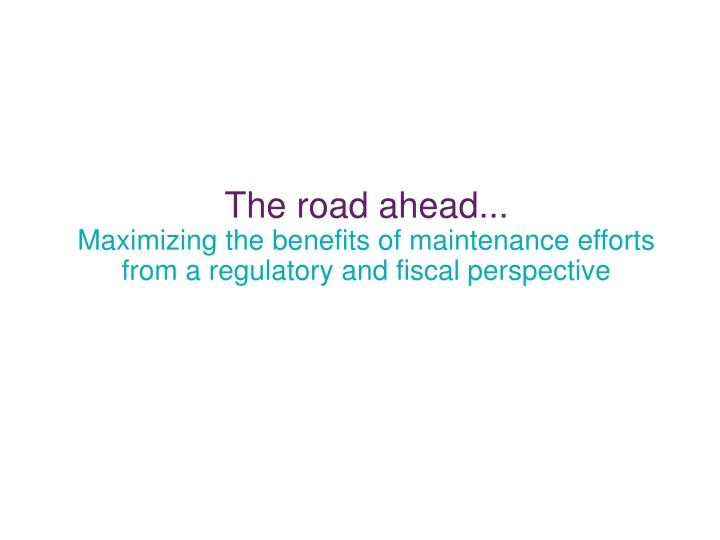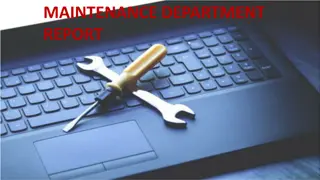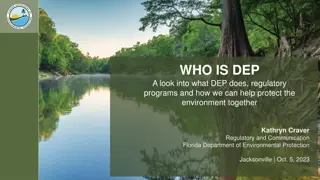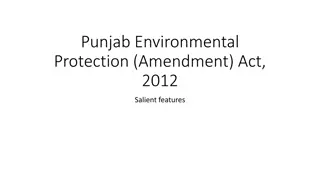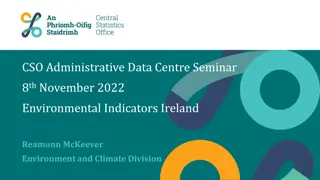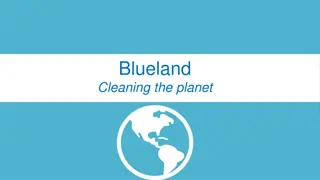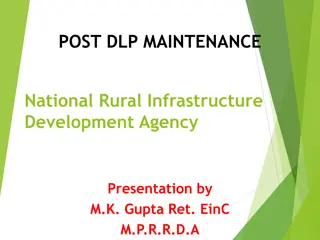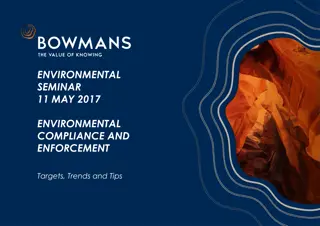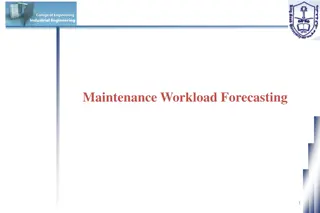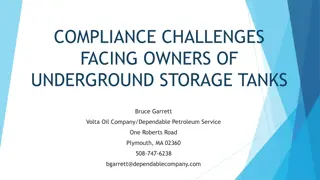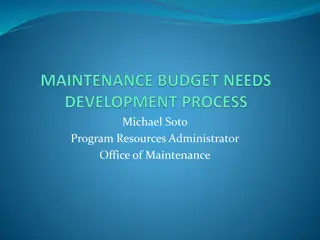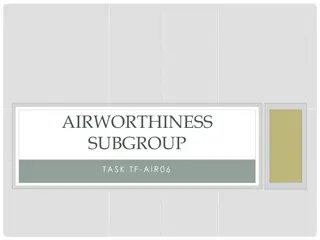Maximizing Maintenance Benefits for Environmental Compliance
Explore the significance of maintenance efforts in maximizing benefits from both regulatory and fiscal perspectives. Learn how routine maintenance activities such as pond cleaning, street sweeping, and litter control can lead to cost savings and regulatory compliance. Discover how keeping track of completed maintenance impacting stormwater runoff can result in significant financial savings and environmental benefits, particularly in meeting pollutant load reduction requirements. Understand the role of maintenance in achieving nutrient pollutant load reduction credits and compare the costs of new BMP construction versus maintenance practices. Find out what information is crucial from maintenance forces for effective environmental compliance.
Download Presentation

Please find below an Image/Link to download the presentation.
The content on the website is provided AS IS for your information and personal use only. It may not be sold, licensed, or shared on other websites without obtaining consent from the author.If you encounter any issues during the download, it is possible that the publisher has removed the file from their server.
You are allowed to download the files provided on this website for personal or commercial use, subject to the condition that they are used lawfully. All files are the property of their respective owners.
The content on the website is provided AS IS for your information and personal use only. It may not be sold, licensed, or shared on other websites without obtaining consent from the author.
E N D
Presentation Transcript
The road ahead... Maximizing the benefits of maintenance efforts from a regulatory and fiscal perspective
Agenda The Real Worth of Maintenance Activities Pond Cleaning Ditch Cleaning Street Sweeping Litter Control FDOT Personnel Awareness of NPDES 2
What comes to mind when you see this? Costly maintenance? Something that can wait another year ? $$ out with seemingly temporary benefit? How about regulatory (and $) CREDIT for a valuable by-product ? 3
Maintenance Unit/District Save Big $$$ By Keeping Track Of All Completed Maintenance That Affects Stormwater Runoff How does this work? First, all FDOT Districts have impaired waters, TMDLs, and therefore pollutant load reduction requirements. Many TMDLs are for nutrients: Total Nitrogen and Total Phosphorus. The TMDL is based on reducing pollutant loads from a referenced condition which inherently accounts for how MS4 operators, such as FDOT, have been doing business. Therefore truly routine maintenance is accounted for in the TMDL. 4
What does the regulatory gun look like? EXCERPT FROM A TYPICAL NUTRIENT TMDL: 5
MS4s (FDOT, Cities, Counties) can achieve Nutrient Pollutant Load reduction credits by: Construction of new stormwater BMPs Implementation of additional maintenance activities Documentation of non-routine maintenance activities 6
Compare new BMP Construction Costs vs. Maintenance Costs Source: Quantifying Nutrient Loads Associated with Urban Particulate Matter (PM) and Biogenic/litter Recovery through Current MS4 Source Control and Maintenance Practices, Univ. of Florida, Sansalone, et al, May 31, 2011 7
So what information is required from your maintenance forces? Let s start with clearing and grubbing work Volume of material removed Description of material Your District NPDES Coordinator can obtain: Nutrient value of the material removed Vegetative Sediment Density of materials 8
Example laboratory print-out of cleared and grubbed material from wet detention ponds 9
Nutrient load removal calculation for pond clearing and grubbing contract Tons of vegetation/vegetation detritus removed- convert to kg of material removed (x kg of material) x (mg of TP or TN/kg of material) = total TP or TN removed from the system Example: Summary of a 2012 District contract for clearing and grubbing 8 Ponds/4.6 acres total/6350 cy hauled 6350 cy PM 656,200 to 1,653,000 lbs PM (Vegetation/Sediment % varied) 4,052 to10,212 lbs TN & 181 to 456 lbs TP $107,223 including clearing/grubbing and MOB, resodding berms, etc. Costs of nutrient removal: $10.5 to $26.5/lb TN and $234 to $592/lb TP Land costs and constructing 4.6 acres of similar ponds may cost about $2-5 million, depending on land costs 10
Nutrient load removal benefits occur with ditch cleaning and pipe desilting These activities also provide pollutant load reductions Weight or volume of material is always the most useful MMS units are linear feet cleaned, therefore average yield rates (CY/LF cleaned) can be tracked and used as secondary estimate Such maintenance activities are not annual . That s okay, let the NPDES coordinator figure out how to get the credits for this work. 11
Street Sweeping Let s revisit the average costs for nutrient removal from various BMPs Source: quantifying nutrient loads associated with urban Particulate Matter (PM) and biogenic/litter recovery through current MS4 source control and maintenance practices, Univ. of Florida, Sansalone, et al, May 31, 2011 12
Highlights of the UF Study Median of the PM recovery from street sweeping is 147 dry kg PM/mile swept Street Sweepings: Median is 361 mg TP/kg PM and 563 mg TN/kg PM (independent of land use) 13
Nutrient load removal calculation for street sweeping contract Tons or cubic yards of street sweepings Moisture content is needed and can be estimated (CY of dry material) X (density of material, lb/cf) x ( 361 mg TP/kg PM swept- from study) x (conversion factor) = total TP removed from the system. Example: Actual District contract for sweeping in an urban city Contractor reported 125 tons per month swept from SHS 12 x 125 tons = 1500 tons (3,000,000 lbs) PM annually Municipality reported 9.9% moisture content 3,000,000 lbs (gross weight) 2,703,000 dry lbs annually 2,703,000 lbs x 361 mg/kg PM x conv. factor = 976 lbs/yr TP removed Contract was worth $183,966 annually Nutrient removal costs: $188.5/lb TP and $120.90/lb TN 14
Summary about street sweeping A good source control BMP that is very cost effective. FDOT Districts are relying on street sweeping load reductions for many of their Basin Management Action Plan commitments for annual load reductions. FDOT Districts are relying on street sweeping as a vital component of their stormwater management plans, particularly for roads in areas developed pre-early 1980s and having no stormwater treatment. 15
Adopt a Highway Litter Control This is an MS4 permit element and is important not only to the NPDES regulator but should be to FDOT as well. Consider: 5.25 trillion pieces of plastic estimated in the world s oceans (269,000 tons) 80% of marine debris comes from land-based sources MMS indirectly reports litter in acres under mowing activities Any activities removing litter should be reported to the NPDES coordinator when possible and volume or weight is the most useful Source: Keep Tampa Bay Beautiful article in Tampa Bay Times, February 7, 2016 16
Awareness of the NPDES Program The NPDES permitting authority (FDEP) and EPA can audit an FDOT office at any time The vast majority of permit violations are documentation issues and/or just plain lack of awareness (and therefore implementation) of the program requirements So, guess who is most likely to be questioned by the EPA or FDEP when an audit is conducted on an FDOT District Office . 17
